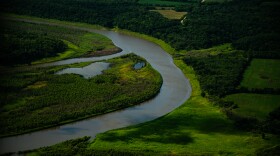-
The central Iowa community of Perry officially opened a $30 million treatment plant that helps meet the state’s goals to reduce pollution from wastewater. City officials said it also increases their capacity to attract new companies and accommodate residential growth.
-
A fertilizer spill killed hundreds of thousands of fish in southwest Iowa last year. Now, a group of locals are building a network of citizen scientists and advocates for clean water.
-
Roughly 25% to 50% of the total commercial nitrogen applied to fields across the state occurs in the fall. Waiting for cooler soil temperatures helps prevent nitrates from flushing into streams and rivers.
-
Water restrictions for nearly a fifth of the Iowa’s population brought the state’s nitrate challenges to the forefront. Water quality experts say certain practices higher up in the watershed could make a difference if they are scaled up.
-
Scientists discussed pollution, bacteria and other challenges plaguing central Iowa's rivers at an event in Des Moines Monday. The presenters contributed to a two-year assessment of the Des Moines and Raccoon rivers, which includes recommendations at the local, regional and state level.
-
Nitrates, fecal bacteria, sediment and other pollutants in the Des Moines and Raccoon rivers threaten safe drinking water for 20% of the state’s population. That's one of the findings from a sweeping study commissioned by Polk County supervisors.
-
Nitrate levels remain elevated in the Des Moines and Raccoon rivers, two of the drinking water sources for Central Iowa Water Works' 600,000 customers. The regional utility recently shared how it tests water and removes nitrates at one of its plants to meet federal drinking water standards.
-
The Des Moines area’s first-ever lawn watering ban helps Central Iowa Water Works keep up with nitrate removal to provide safe drinking water to 600,000 people. Over the next decade, CIWW aims to increase its treatment capacity by 25%.
Play Live Radio
Next Up:
0:00
0:00
Available On Air Stations








